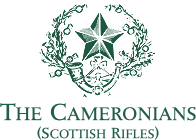 |
www.cameronians.org click here to print this page |
|
|
|
Speech from the Disbandment Anniversary 2008
The Address by Major Philip Grant - delivered the occassion on the 40th Anniversary of the Disbandment of the Ist Battalian at St Brides Church, Douglas, 11th May 2008.
We are here today to commemorate two dates: one 40 years ago and another nearly 300 years earlier. They saw the raising of The Cameronians here in 1689 and the disbandment of the regular battalion on the same spot in 1968.
But history, if it is about anything, is about people. We are here to remember those who raised the regiment, those who fought in it, those who died for their country, and those who finally laid the regiment to rest among these gentle hills.
The original regiment comprised hill men and all were driven by religious fervour. They were products of an angry and disruptive age. Those who signed the National Covenant felt that they were doing for the rights of the individual what their forefathers had achieved for the freedom of their country by signing the Declaration of Arbroath. At heart what they demanded was the right to worship as they chose without interference from the king, his appointees, or from an episcopacy. The most zealous of them became followers of Richard Cameron, the Lion of the Covenant. It was from him that the regiment eventually took it name.
When their Ministers were ejected from their parishes the covenanters followed them to the hills and worshiped at open-air services which came to be called conventicles. As the threat from government forces increased, the covenanters began to carry weapons to their conventicles and to post armed pickets to keep a lookout. This tradition was carried on through war as in peace until the day the Cameronians were eventually disbanded.
The regiment - some 1200 strong and double the size of other regiments - was formed in one day, 14th May 1689, without beat of drum. They mustered here on the banks of the Douglas Water. Their purpose: to support the newly arrived King William. Their first Commanding Officer was William Cleland, whilst their Colonel was the 19-year-old Earl of Angus, son of the Marquis of Douglas. The Earl’s magnificent statue overlooks the spot to this day.
Cleland, a poet and a scholar, must have been an inspiring leader. He was but 28 years old and a self taught soldier. He had earned the respect of his followers by his leadership at the battles of Drumclog and Bothwell Brig. By his side was Alexander Shields who, though not yet ordained, was their spiritual leader, their mentor, and a major influence on all.
Within weeks of their formation The Cameronians saw action as regular soldiers at the Battle of Dunkeld. There they showed their mettle with a staunch defence against a greatly superior number of rebel Highland troops, though it cost Cleland his life.
Just two years later and the regiment was deployed to the Low Countries, and later as part of Marlborough’s force, to fight the French. Their earliest battle honours are a roll call of his finest victories: Blenheim, Ramillies, Oudenarde, Malplaquet.
100 years later and Britain faced the threat of another war with France. To counter this the government authorised the raising of new regiments. Amongst them was the 90th, the Perthshire Volunteers. A tragic and romantic story attaches to their founding by Thomas Graham of Balgowan (later General Lord Lynedoch). This regiment, destined to become the 2nd Battalion, had an entirely different character as well as background. Where the Cameronians had a reputation for being dour and dogged, the Perthshire Greybreeks were raised as Light Infantry, produced a string of very senior officers and accrued no fewer than ten Victoria Crosses in just 24 years.
In 1881 there were major army reforms. It was decided that Scotland should have its own Rifle Regiment. The Cameronians were selected for this promotion and the Perthshire Light Infantry were chosen to become the 2nd Battalion. Together they became The Cameronians (Scottish Rifles). Both battalions now wore the same dark green tunics instead of red, and from 1890, Douglas tartan trews.
In the 1st World War the regiment raised 27 battalions, and over 7000 men lost their lives mainly in France or in the Dardenelles. In the 2nd World War the 1st Battalion was in the Far East and earned an incomparable reputation as jungle fighters. The 2nd Battalion was at the retreat to Dunkirk, and later fought from Sicily to the liberation of Italy. The 6th (Territorial) Battalion distinguished itself in some of the heaviest fighting, in the Low Countries, indeed on exactly the same ground to which the old Cameronians were sent in 1692.
After World War II all regiments were reduced again to one battalion. The new 1st Battalion then saw active service in Malaya, Oman, and Aden as well as spending spells on duty in Cold War Europe. Aden was to be the last posting from which they returned in 1967 with a reputation which bore comparison with any earned during the previous 300 years.
It is said that the original Cameronians fought as they prayed and prayed as they fought. Until recent times each recruit was issued with a regimental bible. The unique character of both the old regiments, reinforced by their 1881 fusion and promotion, and undiluted since then was the reason why, come further defence cuts, it was obvious that there could be no question of another amalgamation. Disbandment, no matter how bitterly regretted, was the only option. That is why the story ends in 1968 on 14th May.
All regiments consider themselves unique: some, I think, are just a little bit more unique than others.
Major Philip R. Grant
Source: 'The Disbandment Souvenir Programnme' published by the Regimental Trustees, The Cameronians (Scottish Rifles).
www.cameronians.org